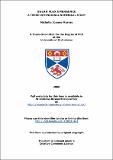Files in this item
Solar flux emergence : a three-dimensional numerical study
Item metadata
| dc.contributor.advisor | Hood, Alan W. | |
| dc.contributor.author | Murray, Michelle J. | |
| dc.coverage.spatial | 249 | en |
| dc.date.accessioned | 2008-03-07T12:38:37Z | |
| dc.date.available | 2008-03-07T12:38:37Z | |
| dc.date.issued | 2008-06 | |
| dc.identifier.uri | https://hdl.handle.net/10023/441 | |
| dc.description.abstract | Flux is continually emerging on the Sun, making its way from the solar interior up into the atmosphere. Emergence occurs on small-scales in the quiet Sun where magnetic fragments emerge, interact and cancel and on large-scales in active regions where magnetic fields emerge and concentrate to form sunspots. This thesis has been concerned with the large-scale emergence process and in particular the results from previous solar flux emergence modelling endeavours. Modelling uses numerical methods to evolve a domain representing simplified layers of the Sun’s atmosphere, within which the subsurface layer contains magnetic flux. The flux is initialised such that it will rises towards the surface at the start of the simulation. Once the flux reaches the solar surface, it can only emerge into the atmosphere if a magnetic buoyancy instability occurs, after which it expands rapidly both vertically and horizontally. The aim of this thesis is to test the robustness of these general findings from simulations to date upon the seed magnetic field. More explicitly, we have used three-dimensional numerical simulations to investigate how variations in the subsurface magnetic field modify the emergence process and the resulting atmospheric field. We initially consider a simple constant twist flux tube for the seed field and vary the tube’s magnetic field strength and degree of twist. Additionally, we have examined the effects of using non-constant twist flux tubes as the seed field by choosing two different profiles for the twist that are functions of the tube’s radius. Finally, we have investigated the effects of increasing the complexity of the seed field by positioning two flux tubes below the solar surface and testing two different configurations for the tubes. In both cases, the magnetic fields of the two tubes are such that, once the tubes come into contact with each other, reconnection occurs and a combined flux system is formed. From our investigations, we conclude that the general emergence results given by previous simulations are robust. However, for constant twist tubes with low field strength and twist, the buoyancy instability fails to be launched when the tubes reach the photosphere and they remain trapped in the low atmosphere. Similarly, when the non-constant twist profile results in a low tension force throughout the tube, we find that the buoyancy instability is not initialised. | en |
| dc.format.extent | 6750885 bytes | |
| dc.format.extent | 10367360 bytes | |
| dc.format.extent | 3584000 bytes | |
| dc.format.extent | 770048 bytes | |
| dc.format.extent | 2854912 bytes | |
| dc.format.extent | 489472 bytes | |
| dc.format.extent | 5371904 bytes | |
| dc.format.extent | 4311040 bytes | |
| dc.format.extent | 1787904 bytes | |
| dc.format.extent | 6434816 bytes | |
| dc.format.extent | 5490688 bytes | |
| dc.format.extent | 11603968 bytes | |
| dc.format.extent | 5019648 bytes | |
| dc.format.extent | 4853760 bytes | |
| dc.format.extent | 6856704 bytes | |
| dc.format.extent | 7518208 bytes | |
| dc.format.mimetype | application/pdf | |
| dc.format.mimetype | video/quicktime | |
| dc.format.mimetype | video/mpeg | |
| dc.format.mimetype | video/mpeg | |
| dc.format.mimetype | video/mpeg | |
| dc.format.mimetype | video/mpeg | |
| dc.format.mimetype | video/mpeg | |
| dc.format.mimetype | video/mpeg | |
| dc.format.mimetype | video/mpeg | |
| dc.format.mimetype | video/mpeg | |
| dc.format.mimetype | video/mpeg | |
| dc.format.mimetype | video/mpeg | |
| dc.format.mimetype | video/mpeg | |
| dc.format.mimetype | video/mpeg | |
| dc.format.mimetype | video/mpeg | |
| dc.format.mimetype | video/mpeg | |
| dc.language.iso | en | en |
| dc.publisher | University of St Andrews | |
| dc.rights | Creative Commons Attribution-NonCommercial-NoDerivs 3.0 Unported | |
| dc.rights.uri | http://creativecommons.org/licenses/by-nc-nd/3.0/ | |
| dc.subject | Sun | en |
| dc.subject | Flux emergence | en |
| dc.subject | Numerical | en |
| dc.subject | Simulation | en |
| dc.subject.lcc | QB539.M23M8 | |
| dc.subject.lcsh | Solar magnetic fields--Mathematical models | en |
| dc.subject.lcsh | Magnetic flux | en |
| dc.title | Solar flux emergence : a three-dimensional numerical study | en |
| dc.type | Thesis | en |
| dc.contributor.sponsor | Particle Physics and Astronomy Research Council (PPARC) | en |
| dc.type.qualificationlevel | Doctoral | en |
| dc.type.qualificationname | PhD Doctor of Philosophy | en |
| dc.publisher.institution | The University of St Andrews | en |
This item appears in the following Collection(s)
Except where otherwise noted within the work, this item's licence for re-use is described as Creative Commons Attribution-NonCommercial-NoDerivs 3.0 Unported
Items in the St Andrews Research Repository are protected by copyright, with all rights reserved, unless otherwise indicated.


